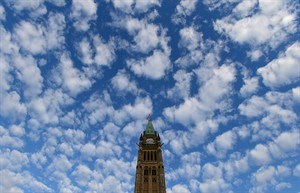
The Peace Tower is seen on Parliament Hill in Ottawa on November 5, 2013. The movers and shakers on Parliament Hill usually know where the bodies are buried. But deposits of human bones uncovered within sight of the Peace Tower seem to have caught everyone off guard. THE CANADIAN PRESS/Sean Kilpatrick
December 07, 2013 - 3:00 AM
OTTAWA - The movers and shakers on Parliament Hill usually know where the bodies are buried.
But deposits of human bones uncovered within sight of the Peace Tower seem to have caught everyone off guard.
Construction workers digging out part of downtown Queen Street have come across yet another burial under the busy road, the third finding of human remains since September.
The excavation is to upgrade old watermains before the Big Dig, a massive tunnelling project for light-rail-transit trains that will rumble for 2.5 kilometres under the city core, dubbed the Confederation Line.
But some pre-Confederation history has been mucking up the process.
Archeologists believe workers have stumbled onto an old Methodist cemetery, part of a burial ground established in the early 19th century, when this part of Ottawa was called Upper Bytown and well before it became Canada's capital.
The watermains themselves are of more recent vintage, the oldest parts dating to 1874.
The watermain work was first halted Sept. 19 when bones were identified in a dig at Queen and Melcalfe Street, and the police called in. The remains were found only about a metre below ground, above the mains. Police forensic officers confirmed the bones were human.
The coroner's office soon ruled out criminal activity. The matter was deemed archeological, and the finding turned over to the jurisdiction of the Ontario Ministry of Tourism, Culture and Sport.
Since then, two more burials were uncovered in other watermain work, one of them many metres farther east along Queen Street.
The archeological investigation has been turned over to consultant Benjamin Mortimer, of Paterson Group. A preliminary report is expected this month, with more on-site investigations planned for the spring.
"The archeological investigation on Queen Street is still ongoing," said City of Ottawa spokeswoman Courtney Ferguson. "When it is concluded, there will be a report to the city with all the details of the excavation."
At least three historical maps clearly show a cemetery in the vicinity, established in 1828 for military and civilian dead. But the burial ground was closed in the 1850s and initial surveying for this year's watermain work did not note the possibility of finding bones in gravesites.
The first bones encountered appear to have been previously disturbed, perhaps during construction in the area in the 1970s.
"Subsequently, additional human remains and evidence of burial shafts were discovered," said Sue Carroll, an Ontario government spokeswoman in Toronto.
"Currently, the remains are believed to be associated with the Queen Street Methodist Cemetery."
So far, there's no information about the age or gender of the deceased individuals, though an internal Ontario government report currently lists them as "Euro-Canadian."
Documents related to the discovery were obtained by The Canadian Press under the province's freedom-of-information legislation.
"Some of the disturbed and fragmented remains have been collected by the archeologist and have been secured," said Carroll.
"Those areas with additional partial burials have been secured and protected so that the further investigation can be completed on spring 2014."
City officials say the gravesite discoveries are not expected to delay the main LRT tunnel construction.
News from © The Canadian Press, 2013